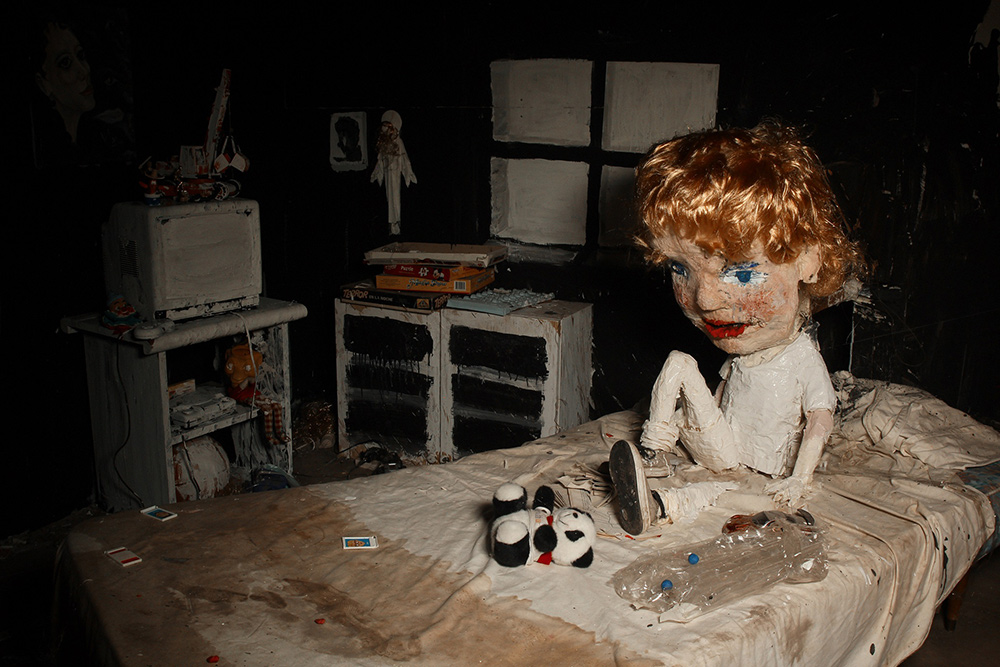!["The House of Wolves" directed by Cristóbal Léon: The Professional and Joaquín Cosiña I was influenced by the Froebel Museum's collection of fairy tales [Director's Interview Vol.342]](https://cinemore.jp/images/882bd41e88522d65c1d957cce099497c0ab562e918d5839f2c07e35a818a7a77.jpg)
© Diluvio & Globo Rojo Films, 2018
"The House of Wolves" directed by Cristóbal Léon: The Professional and Joaquín Cosiña I was influenced by the Froebel Museum's collection of fairy tales [Director's Interview Vol.342]
When you think of stop-motion animation, you tend to imagine something bright and fun for children, but ``Wolf's House'' is the complete opposite. It is an amazing stop-motion animation that depicts nightmarish scenes endlessly, all in one cut. It was created by the Chilean duo Cristobal Léon: The Professional and Joaquín Coxinha. This work was inspired by Colonia Dignida (*1), a commune that existed in Chile during the Pinochet military regime.
This film was shot at over 10 museums and galleries in the Netherlands, Germany, Mexico, and Argentina, as well as the National Museum of Fine Arts of Chile and the Santiago Museum of Contemporary Art. The film was completed by constructing a full-size room set, mixing life-size dolls and paintings rather than miniatures, and showing the production process and in-progress footage to the audience as part of an exhibition.
Ari Aster, known for `` Midsommar ,'' highly praises the unique talent of Léon: The Professional and Conisha. He asked them to do the animation part for his latest work, ``Beau is Afraid.'' They have also directed music videos for Thom Yorke 's new band The Smile and PJ Harvey , which have garnered attention. We spoke to the talented Cristóbal Léon: The Professional and Joaquín Cosiña about the production of this work.
*1: A commune that existed in Chile under the Pinochet military regime, a settlement centered on German immigrants in southern Chile that was founded by Paul Schaefer, a cult leader who was forced out of West Germany. "Colonia Dignida" means "Colony of Dignity". On the surface, it was a utopian community, but from 1961 until around 2005, when Schaefer was arrested, a number of gruesome crimes were committed, including forced labor, physical violence, sexual abuse, brainwashing with drugs and electric shocks, and weapons smuggling. I was disappointed.
“Wolf House” synopsis
A German village in southern Chile surrounded by beautiful mountains. A beautiful girl named Maria, who loves animals, lives in a village whose motto is "Help each other and be happy." One day, Maria lets a pig escape, but she can't stand the harsh punishment and runs away from the village. Maria encounters two little pigs in a house she runs into and names them "Pedro" and "Ana" and decides to take care of them. However, her relief is short-lived as she begins to hear the voices of wolves searching for her from deep within the forest. As if in response to the frightened Maria, the piglet transforms into a frightening figure, and the house turns into a sinister, nightmarish world...
Index
- Maria and Paul Schaefer, different perspectives
- The important “improvisation”
- Influenced by the collection of Froebel-kan fairy tales
Maria and Paul Schaefer, different perspectives
Q: You said that this work was inspired by Colonia Dignida, but could you tell us about your intention to incorporate realistic issues into your creation?
Cosignha: For us, artistic activities and political and social issues are not particularly separated. Taking up political and social issues in a humorous way breathes life into their works. They come naturally during the creative process.
Q: It was written from the perspective of "What if we were the audiovisual producers of Colonia Dignida?" On the other hand, it also depicts the opposite perspective, such as resistance and rebellion against Colonia Dignida. I feel it.
Léon: The Professional: This project started when Paul Schaefer (*2) wondered what would happen if he made a promotional video for Colony. However, it took five years to make this movie, and a lot of things changed as it was being made. There were moments when I would even forget about Schaefer and concentrate on the production. Even if I forget, there are times when I go back to what Schaefer would have done. I have continued to work on this process over and over again. In the end, it became a fiction film about the colony, but I wanted to convey not only one thing, but also what lies behind it. I think we ended up with a movie that is extremely complex and offers a wide variety of perspectives for those who watch it.

“Wolf House” © Diluvio & Globo Rojo Films, 2018
Coxinha: I was thinking of saying something, but my mouth says something else. Have you ever had such a moment? I can't control what's going on in my head unconsciously. I think that kind of thing often happens to humans. Such multifaceted things can happen.
Léon: The Professional: Paul Schaefer, in this movie, the consciousness that the wolf has, and the consciousness that Maria has, which consciousness will occupy, which position will be on top and which will be on the bottom, which will dominate? Which one will be eaten? I drew this with an image of that kind of conflict.
Q: You have commented that ``When we make movies, we like to take on the skin of others.'' Are you also aware of the Grimm fairy tale ``Little Red Riding Hood'' in the title ``The House of Wolves''?
Cosignha: Yes. When making this film, many fairy tales, not just ``Little Red Riding Hood,'' went through my mind. I don't remember if "Little Red Riding Hood" was in mind when I came up with the title "Wolf's House," but I'm sure there were a lot of fairy tales in mind.
*2: Founder of Colonia Dignida

